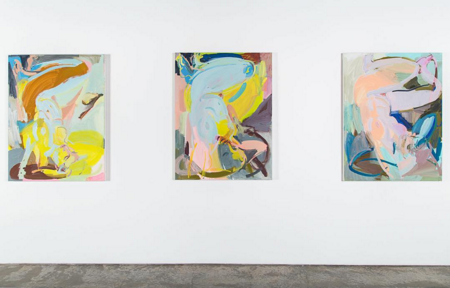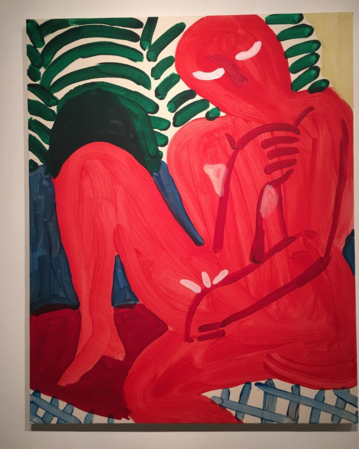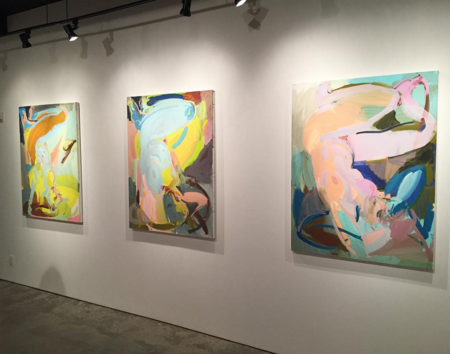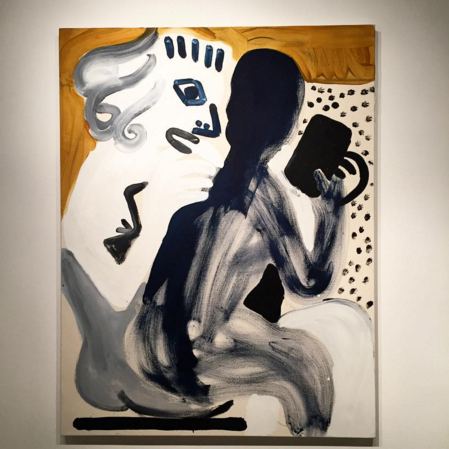The group exhibition at Garis & Hahn suggests that something different takes place when women paint female nudes apart from the scrutiny of men.
In 1989, the masked activism group The Guerrilla Girls exploded onto the art scene with _Do women have to get naked to get into the Met. Museum?_ (1989) - a satirical advertisement that appeared on the side of New York City buses (until the contract was canceled because the bus company deemed the image too risqué). The statistics the Guerrilla Girls cited might seem unremarkable for 1989 – less than 5% of the artists in the modern art section of the Met are women, but 85% of the nudes are female. In 2012, however, the statistics of the “weenie count” – as the Guerrilla Girls called it – were just as astonishing, with 4% of the artists and 76% of the nudes in the modern art section being women. It seems that women do, in fact, have to strip to make their way into art history.
[](http://images.squarespace-cdn.com/content/v1/56c346b607eaa09d9189a870/1487293246814-IMI4O8IN5TD56HYSSO7M/Screen-Shot-2016-04-14-at-14.45.57.png.57.png?format=original)
It is this inequity that provided the impetus for _Beyond the Gaze: Women Painting Women_ at Garis & Hahn, a group exhibition featuring Sarah Awad, Tatiana Berg, Sarah Faux, and Jay Miriam. The exhibition suggests that something different takes place when women paint female nudes apart from the scrutiny of men, but the nature of the resulting reversal is intentionally ambiguous, especially since few of the paintings are actually discernably of women. The majority of the artworks are, in fact, highly abstract, and self-consciously so. Sarah Awad’s _Reclining Woman (Triptych)_ (2014) presents a female form that seems to emerge from the paint itself, as if to suggest that all artists must inherently deal with issues of gender the moment their paint leaves its tube. In this way, art need not be expressly political in order to be deemed “feminist” or “activist.” Painting is in itself a subversive act, even in 2016.
[](http://images.squarespace-cdn.com/content/v1/56c346b607eaa09d9189a870/1487293247331-MMAUA21TOM1636588WD8/Screen-Shot-2016-04-14-at-14.46.54.png.54.png?format=original)
Moreover, the artists tackle important historical questions with simultaneous humor and seriousness that makes for an accessible and educational space. Tatiana Berg’s explosive colors are visually arresting, especially in the uniquely spot lit gallery space, but, equally, her canvases deal subtly with the history of gender, abstraction, and expressionism. In _Afternoon Studio_ (2016), Berg references the fluid, malleable forms made famous by Matisse, but her nude casually touches herself with an unexpected nonchalance that would cause the old white guys of art history to quiver with shock (and a bit of jealousy). This act is only signaled by three white brushstrokes, reminiscent of Keith Haring’s cartoonish, but always pointed, images. _Afternoon Studio_’s lady in red thereby indulges unabashedly in the pleasures of her own body, and she knows her art history to boot.
[](http://images.squarespace-cdn.com/content/v1/56c346b607eaa09d9189a870/1487293245827-CB2A7BENGHAP96TSL1GK/Screen-Shot-2016-04-14-at-12.39.26.png.26.png?format=original)
Likewise, Jay Miriam’s _Woman and Headless Parrot_ subtly refers to the history of Surrealism while upholding the importance of self-empowerment. The Surrealist painters and photographers of the early 20th century were obsessed with insect life because, especially with praying mantises, the female spouse is known to decapitate her male partner. It goes without saying that men are always afraid of a strong woman. Though we might not make the same associations that the kinky Surrealists did, there is nevertheless a sense of urgent, perhaps violent or tumultuous, motion in _Beyond the Gaze_, even in Sarah Faux’s understated abstractions.
[](http://images.squarespace-cdn.com/content/v1/56c346b607eaa09d9189a870/1487293247423-XPZDWLKR1TTEHWOGRZ5A/Screen-Shot-2016-04-14-at-14.47.08.png.08.png?format=original)
It is not be possible to pin down a unified message or call to action, and it is exactly from this uncertainty that the exhibition draws its power. The poison of heterosexism is visible and dire, a fact that these artists do not diminish. Still, discrimination cannot stop creativity; in fact, it might produce entirely new artistic avenues that thrive despite oppressive circumstances.
[](http://images.squarespace-cdn.com/content/v1/56c346b607eaa09d9189a870/1487293316237-GYUWV17E8TO0UACLOB3V/Screen-Shot-2016-04-14-at-14.46.07.png.07.png?format=original)
_Beyond the Gaze: Women Painting Women_ will run through April 17th at Garis & Hahn gallery in New York.
[Here](http://garisandhahn.com/) you can find more information about the gallery and the exhibition.
